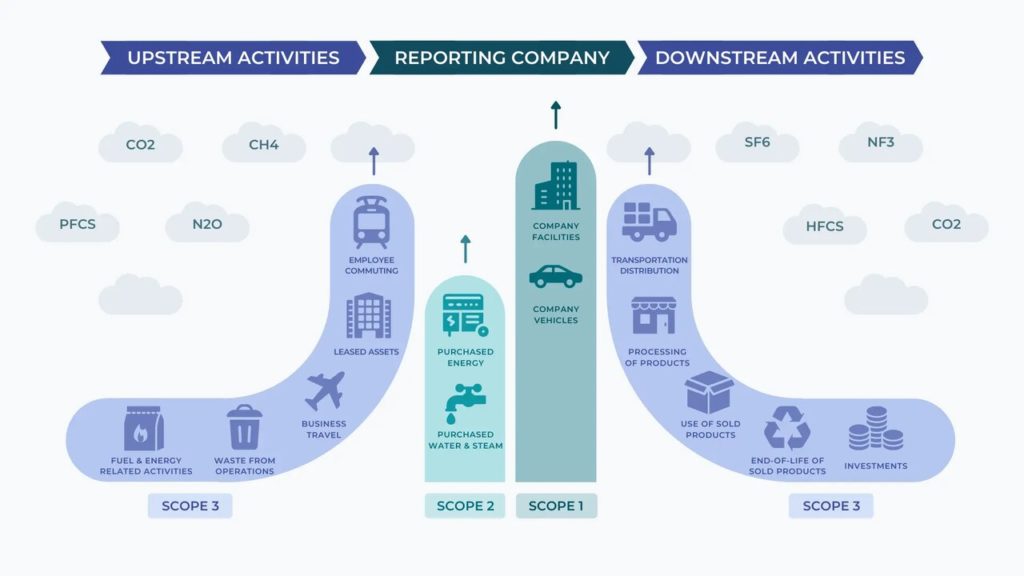
As environmental awareness spreads, businesses are taking the matter into their hands by setting up sustainability strategies. A fundamental part of these strategies are corporate carbon reports, which are, in other words, reports about the greenhouse gasses emissions produced by a company. If you’ve already seen one of these reports or plan to do one for your business, you might already have heard of emission scopes 1, 2, and 3. In this article, we’ll explain what they are and why they are included in a carbon report.
What is a corporate carbon report?
A corporate carbon report describes in detail all greenhouse gasses emissions related to a company’s activities along the entire value chain. The report includes greenhouse gasses such as carbon dioxide, methane, nitrous oxide, and fluorinated gasses, which are all converted to a common unit, the CO2 equivalent (CO2e), to facilitate comparisons.
To calculate the emissions, you can use standard international frameworks, such as the GHG protocol, ISO 14064, or the Association Bilan Carbone. The GHG protocol is the most widely used standard and takes into account all CO2e emissions from direct and indirect sources, which are divided into scopes 1, 2, and 3.
It’s important to define the boundaries of the organization beforehand in order to understand who is responsible for the emissions. Generally, the responsibility of scope 1 and 2 emissions is attributed to the reporting company, but you aren’t held responsible for scope 3 emissions. However, you can reduce your scope 3 emissions through various reduction strategies.
You want to start somewhere but you’re not sure where? Estimate your company’s impact in just 3 minutes.
What are scopes 1, 2, and 3?
In brief, scope 1 emissions are the direct emissions from sources owned or controlled by your organization, scope 2 emissions are indirect emissions associated with your company’s energy consumption and scope 3 emissions are indirect emissions produced by other activities.
These three scopes of emissions are divided into other categories, allowing you to better understand the impact of each activity. The picture below shows that scope 1 and 2 emissions are attributed to the reporting company, while scope 3 emissions are divided intoupstream and downstream activities.

What are scope 1 emissions?
Scope 1 emissions are direct greenhouse gasses emissions produced by sourcesowned or controlled by the organization. For example, it includes the emissions produced by boilers, furnaces or vehicles owned by the company.
What are scope 2 emissions?
Scope 2 emissions are indirect energy emissions associated with the production of electricity, heat or steam imported for operations. These emissions are physically produced outside of the company’s boundaries.
What are scope 3 emissions?
Scope 3 emissions are related to your complete value chain,but they’re not directly produced by the reporting company.These emissions are believed to have the most significant impact out of the total footprint of a business, accounting for an average 75% of a company’s total emissions. Scope 3 emissions include business travels, the purchase of goods and services, waste management, etc.
Although the reporting company isn’t held responsible for these emissions, there are actions that can be taken to reduce them. For example, using more energy-efficient means of transport or choosing sustainable partners for logistics can help in reducing scope 3 emissions.
You want a corporate carbon report for your business?
Understanding in which scope each carbon emission source belongs might be complicated at first. This is why Tapio has divided carbon emissions sources into 8 categories that include all the three scopes. They are easier to visualize and they will allow you to communicate more transparently to stakeholders.
The 7 categories of a company’s carbon emissions are the following:
- Energy consumption
- Mobility
- Logistics
- Goods and services
- Waste
- Capital goods
- Others (homeworking, investments, etc.)
Tapio is a carbon management platform that will allow you to create a customized carbon report. Through our expertise and technology, you can calculate your carbon footprint, develop a carbon reduction strategy and communicate about your results with your stakeholders.
Book a demo with one of our experts to learn more.